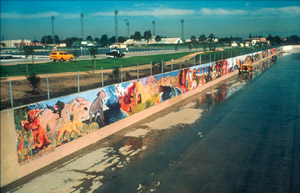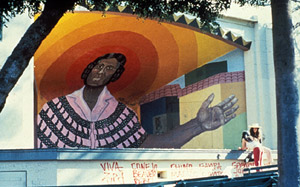LA MURALS ORIGINS
https://sparcinla.org/brief-history/
Murals in Los Angeles were the first artistic medium to support and then shape a movement toward identity and justice that reached a mass population. This artistic occupation of public space forged a strong visual presence of a people who at that time (late ’60’s, early ’70s) lacked representation in public life, with neither voice in elections, nor elected representatives. No person of Latino descent served on the City Council or on the School Board, despite the fact that in actual numbers we were fast becoming the majority of the population. Parallel to and perhaps growing from this new visual strength, many citizens of emerging Latino communities organized, with very little money and freely given labor, toward the mutual goal of improving the conditions of their communities. While many of the early Chicano Muralists were the first generation with advanced degrees in their communities, a racially unsophisticated society, tied the Chicano artist to the conditions of the barrios or Latino neighborhoods regardless of their educational status. SPARC was born of the spirit of this movement, taking its name from the notion that it takes only a spark to start a prairie fire. The organization has been intent on nurturing this healthy fire within the city as a whole for nearly 40 years.
As the fire of muralism progressed distinctions began to emerge. Apart from its initial purpose of creating a capacity for the imagery of the people to occupy public space, Los Angeles murals spoke to the cultural demands of previously under-represented peoples. Some works became cultural-affirmation images, asserting only that we exist as distinct cultures; others addressed the hard task of articulating and advocating for resolution of issues affecting the places where our people lived and worked.


This new social power was not limited to immigrant labor nor indigenous people but spread to the multiplicity of Los Angeles populations. African American, Thai, Chinese, Jewish and women’s murals began to appear on the streets of Los Angeles. Before long, community murals began to attract media attention and documentation. Murals began to tackle larger issues of police brutality, border crossings, drug addiction, gang warfare, and other difficulties of a life of poverty and exclusion. Early in the movement space was freely available and uncontested. If you had the paint and the time, the wall and the message were yours. In this environment the movement flourished. In the early seventies a visitor could drive from site to site and could have seen Carlos Almaraz, David Botello, Willie Herron, and I all painting simultaneously on the streets of Los Angeles.
In 1970, I began working for the Los Angeles Department of Recreation and Parks, teaching art in Boyle Heights, a neighborhood with the highest number of gangs in the United States. Similar to the neighborhood I grew up in (Pacoima), Boyle Heights had cultural markers — graffiti —with roll calls written on the walls that told you who lived there, what the neighborhood was called and who was from there. But this stylized iconography often triggered destructive conflict, part of the contesting of public space by rival gang members. I began working with gang members from different neighborhoods to establish networks between them to promote peaceful solutions to such conflicts. Redirecting gang members’ inclinations toward public expression via my own artistic training as a painter, we began painting murals as a way to create constructive cultural markers.
One day as we were painting I came face-to-face with the General Manager of the Department of Recreation and Parks, Sy Greben. He had recently taken that job after having served as the Director of the Peace Corps for President John F. Kennedy’s administration. He asked, “Are you being paid to do this work?” Since Mr. Greben was the highest-ranking person in the department, I was afraid to answer for fear that not having official status as city employees, our painting of park walls would be halted. “No,” I said politely, “I am an art teacher in your parks working on my own time.”